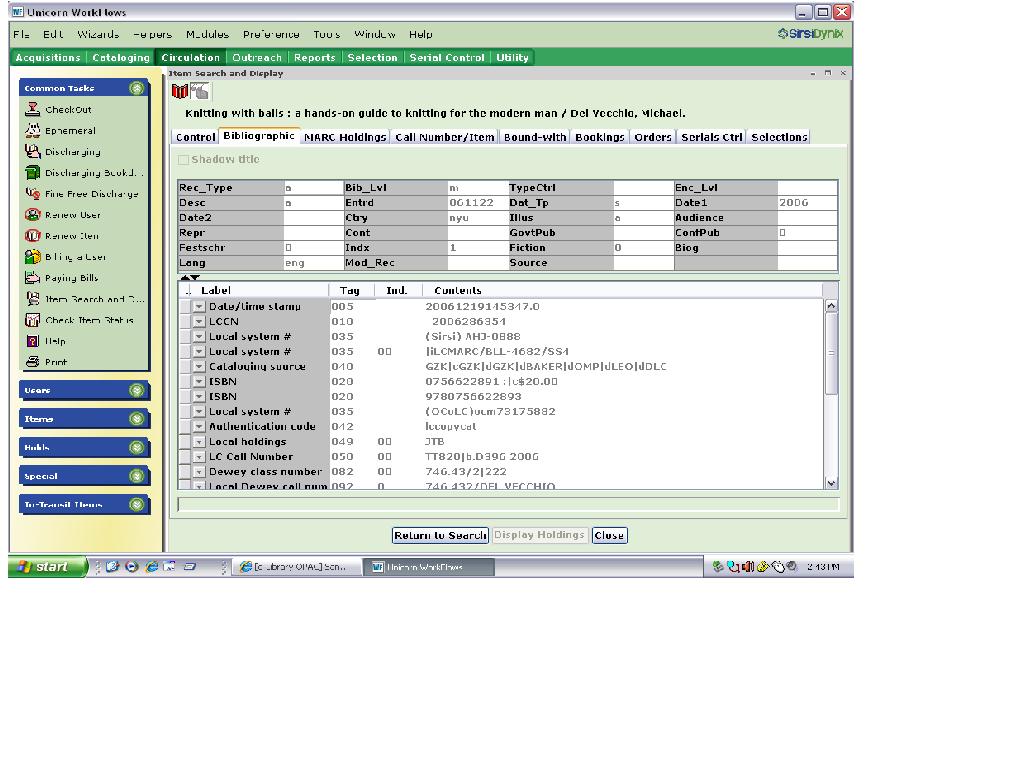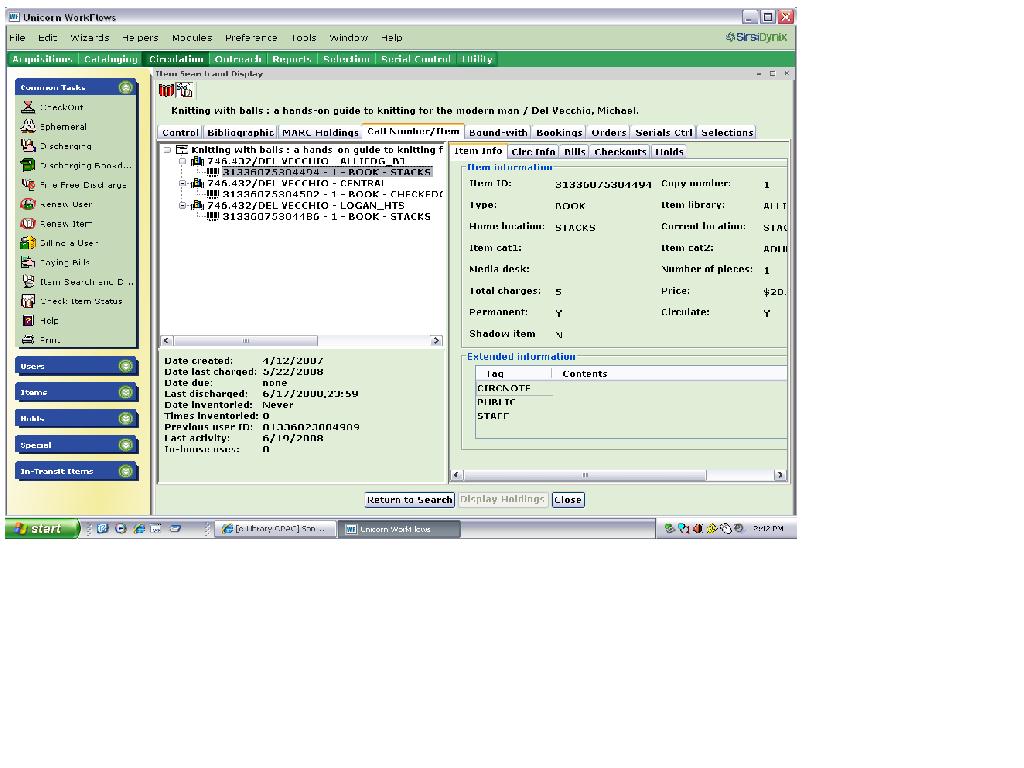As an assignment for my Information Technology class, we had the option of creating either a blog entry or a podcast to demonstrate our understanding of a number of information technologies. I really wanted to do a video podcast, but my schedule had me out of my library for a few days and so I didn't have time. Instead, I'm putting this assignment here on my knitting blog. Professor Smith, please don't laugh at my
socks.Integrated Library SystemsDescription
Integrated Library Systems (ILS) is a software product that can be utilized in libraries to streamline operations. A typical ILS can consist of different modules which are used to control functions such as circulation, cataloging, acquisitions and serials management. Two important components of an ILS are (1) the holdings database and (2) the patron database. Another important component is the Graphic User Interface. This allows library staff greater ease of viewing and manipulating records, many of which are more machine-readable, such as catalog records.
How is it used in a library?
When issuing library cards to patrons, the patron database can be searched to see if potential users have had previous library cards. Searches can be conducted not only by name, but also by and ID number or address, for example.
When cataloging new items, MARC records can be downloaded in a batch process and the information added to the library’s holdings. Hundreds of items can be processed overnight and then be ready for catalogers to look over them.
A librarian in one location can search for an item a patron is interested in. If the item is not available at the present location, a hold may be placed on an available copy at a different location using a patron’s library card. The system then generates a report instructing staff at location B to pull the item and route it to location A. Once the item is received at location A, a notice is generated for the patron. If the patron does not pick up the item within a prescribed amount of time, another report is generated to return the item to location B, and if applicable, bill the patron for reshelving.
Expected social impact of the technology
I have a unique perspective in terms of this technology as the library system I work for has recently converted to a new ILS (SirsiDynix’s WorkFlows). One interesting aspect of such a conversion is that younger staff members appear to have made the transition more smoothly than veteran staff members. This group is quickly becoming the most proficient at the system. I’m wondering if this phenomenon will repeat itself as other information technologies become more commonplace in libraries.
OPACDescription
The OPAC, or online public access catalog, can be defined as a patron interface to parts of the ILS, mainly the library catalog and their own patron record. Item records are converted from the MARC record into a format that can be easily understood by a patron. For example here are records for the book
Knitting with Balls as seen in the ILS.


Now view the same record in the OPAC. It is much easier to understand.

How is it used in a library?
The OPAC is the card catalog of today. Instead of searching little drawers categorized by author, title, or subject, a patron still conduct a search in that fashion, only he now enters the search term in a box and with the click of a mouse decides if it is an author, title, or subject search. The OPAC also can also allow for other search strategies, such as keyword or even call number. In addition, through the OPAC a patron has access to various databases subscribed to by the library, such as newspaper and magazine files. No longer does a specific location have to subscribe to a particular magazine or journal for the patron to use it; nor does a specific issue have to be on the shelf. This is especially useful for students using their neighborhood branch libraries who now have access to academic journals that might have been traditionally only held at a central or main library.
In addition to being able to easily search holdings of library systems that contain millions of items, patrons can use the OPAC to view their own library accounts. They can verify what items they have checked out and the due dates, they can renew items and view what titles they may have placed on hold. In an academic library setting, students can access materials placed on reserve by their professors.
I think the most significant factor of the OPAC is that it is available online not just at the library site, but through the Internet. In fact, some libraries refer to their OPAC as another branch.
View Harris County Public Library’s eBranchExpected social impact of the technology
Disintermediation: patrons have the ability access their own library accounts and renew their items without help from a live staff member. I think that the average computer literate library patron sees OPACS as the library’s way of becoming digital. From their perspective, the library website has joined the ranks of Google and Yahoo. As a library professional, I can only hope that an understanding of what resources are available through the OPAC, as opposed to a search engine like Google, will increase the relevance of the OPAC when it comes to information literacy. For the end user of the OPAC who tends to be a patron rather than a library staff member, the impression seems to be that library services are finally coming online, and will be utilized like any other disintermediated service such as online banking. As a result, the role of the information professional is beginning to shift from that of information provider to that of information mediator.
Web FilteringDescription:
When one thinks of web filtering in libraries, the obvious thing that comes to mind is Internet filtering. Most public libraries, in order to comply with the, have installed Internet filters on computers that can be accessed by minors.
View San Diego Public Library's Internet PolicyThe majority of Internet filters work by denying access to certain categories of websites such as pornography, violence, and profanity. Filtering software also allows one to keep a certain “whitelist” of websites that can be visited and/or a “blacklist” of sites that cannot be accessed. Because of the huge number of websites added to the Internet on a daily basis, a common practice is to set categories to block and then view a list of sites that a user has attempted to gain access. If such a site can be deemed benign, it can then be placed on the whitelist. Parents can also use web filtering software to monitor chats and assign specific times to when their children can be online.
How is it used in a library?
In many public libraries, filtering software has been installed in order to comply with the
Children’s Internet Protection Act (CIPA). This allows institutions to receive funding for Internet access through the Federal e-rate program. The ALA has unsuccessfully attempted to overturn this ruling. However, filtering software can be disabled for patrons of majority age.
Expected social impacts
Free Inquiry and Access: Again, I am answering this question having had experience working in public libraries that in the past had provided unfiltered access to the Internet. Dealing with patrons viewing inappropriate sites, namely pornography, was a constant headache. Filtering software has greatly reduced this problem. Given that public libraries are an important tool in bridging the digital divide, filtering software has allowed for the continued maintenance of a safe surfing environment for all, to the extent of the users’ skills. I emphasize that filtering software does not, and should not, take the place of a parent’s vigilance when it comes to children surfing the Internet.
Blogs
Short for weblogs, blogs are basically online diaries. If you care to explore my blog, you can go through some of my older posts and see what I care to write about. As I had started this blog to chronicle my knitting experiences, that is what my blog is mostly about. Only recently have I expanded to speak occasionally about other things such as photography and beer.
How is it used in a library?
Many libraries keep a blog as a quick way to post information. Almost anyone can post to a blog with a minimal amount of training. For a library, a few people might be entrusted with this responsibility, and information can be posted onto a blog much faster than updating a traditional web page.
The
California State Library blog “is designed to share information regarding California State Library programs and services, and to highlight topics relevant to California’s library community.”
On a much smaller note, a blog might be used as a quick way to keep employees apprised of what’s happening at work. When I completed service learning hours at The Chula Vista Public Library, I discovered that the organization keeps an internal blog that greatly facilitates communication between their three facilities. Each facility posts minutes from their “5-minute meeting” held at the beginning of each workday. Here it is easy to see if certain staff members are present that day. If an announcement needs to be made to the entire staff, it is certainly easier to make it on the blog than to go to each staff member in person. Staff members who do not start their shifts at the beginning of the workday can easily be brought up to speed.
Expected social impacts
Blogging is a good example of Computer Supported Cooperative Work. In the Chula Vista Library example, the technology was put to work for the organization. In return, I am sure that a culture had to be formed, in terms of proper communication (much like email etiquette) and also the need to view the blog in order to stay on top of current events.
Another social impact of blogging is its effect on the culture of the organization. Because it is so easy to start a blog, many people do. I direct your attention to a link on my left-hand side, under Blogs.
The City Heights Library Blog was started earlier this year by a colleague who sought to use this technology as a form of outreach to our patrons. Posts included new books at the library and events such as storytimes and crafts. The blog received several unique hits before being ordered shut down by the library administration, namely the Public Information Officer who felt that such communication lay solely in her realm and duplicated her efforts.
In my opinion, I believe that RFID will improve libraries more for librarians than for the patrons. Sure, the trickle down effect will be that service to patrons will be improved, but the immediate benefit is really for library staff. Implementing RFID in an existing system is definitely pricey though, and it could be several years before the initial cost pays itself off. However, the proper use of RFID should allow for a more accurate inventory of library holdings and less errors in circulation. The data collected through RFID might even be used to prove to patrons when items were returned, important information in case fines are disputed and/or denied.
I think that OPACS have and will continue to improve libraries for the patrons. Because of Google and other search engines, it seems like everybody thinks they are an expert at searching the Internet. OPACs have been developed somewhat along those lines, yet it important to maintain the distinct differences between OPACs and the Internet. OPACs have shifted some power from librarians to the patrons themselves; as I said before, it kind of reminds me of online banking. However, librarians will still be needed for the tacit information that cannot be located with a computer.




